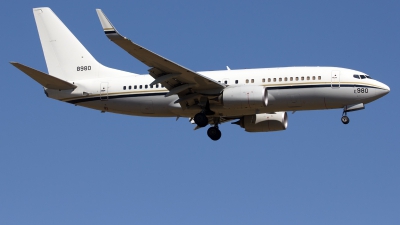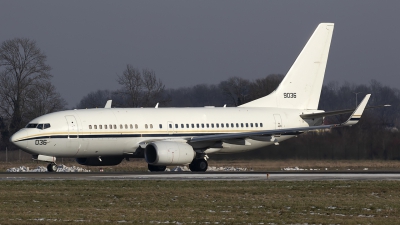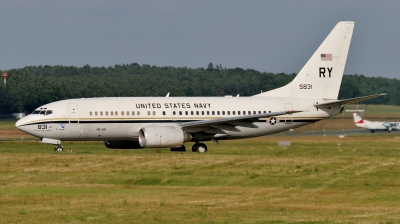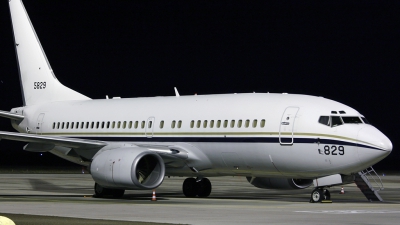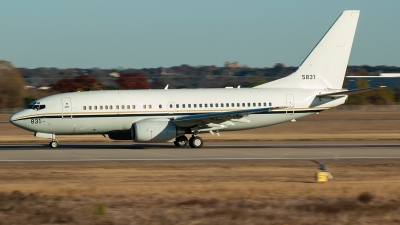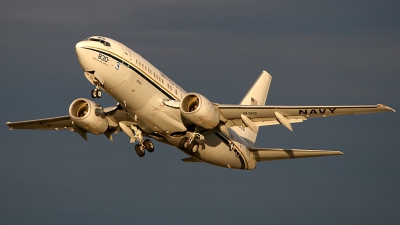Boeing C-40A Clipper (737-7AFC) Aircraft Data
The Boeing C-40A is based on Boeing's next-generation 737-700C civil aircraft. The first flight of the aircraft took place in April 2000. The first of the C-40A aircraft entered service with the United States Naval Reserve Fleet Support Squadron in April 2001. The ninth was delivered in June 2006. The US Navy placed an order for two additional aircraft in December 2008, for delivery by February 2011. The first aircraft was delivered in November 2010 and second in January 2011. The USN has a requirement for up to 20 additional aircraft.
The aircraft are certified to operate in three configurations – all-passenger (121 passengers), all-cargo (up to eight pallets) or combination ('combi') configuration that will accommodate up to three cargo pallets and 70 passengers on the main deck. The US Naval Reserve will staff and operate the aircraft.
The navy has used standard commercial practices to purchase the aircraft. The aircraft are stationed at Naval Air Station Carswell Joint Reserve Base, Fort Worth, Texas, and the Reserve Fleet Logistics Support Squadron 58, based at Naval Air Station Jacksonville, Florida.
The Boeing management team for the program is led by Boeing Derivative Airplane Programs in Seattle. The manufacturing of the fuselage is carried out at the Boeing production facility in Wichita, Kansas, prior to the build-up and assembly of the aircraft in Renton, Washington. The aircraft then proceeds to flight testing in Seattle and, finally, to the combi modifications and certification in Wichita.
The Naval Reserve provides the line maintenance on the aircraft. For the first three years of service, an industrial partnership between Boeing and Delta Air Lines, provided the interim contractor logistics support, providing fleet management, spares management and heavy maintenance.
Design
As the aircraft is based on a civil airliner design, it is suitable for deployment to civil airports or military air bases. It has an aluminium alloy fail-safe fuselage and wing structure and incorporates the strengthened wing design of the Boeing 737-800 and Boeing Business Jet (BBJ).
The undercarriage of the aircraft has been strengthened to accommodate the increased gross weight. The hydraulically retractable tricycle-type landing gear is fitted with Boeing shock absorbers and Honeywell or Goodrich brakes.
Flight deck
The two-crew flight deck of the Clipper retains the features of the glass cockpit installed in the commercial 737-700 aircraft with a Honeywell common display system and five flat panel liquid crystal display screens.
Systems include a dual flight management system and an integrated global positioning system.
In an all-passenger configuration, the cabin accommodates 121 passengers. Alternatively the cabin can be fitted in an all-cargo or combination configuration that will accommodate up to three cargo pallets and 70 passengers on the main deck. The cabin has a strengthened floor and cargo handling systems.
The forward cargo door, measuring 11ft wide by 7ft high and installed on the port side of the main deck, is the most prominent modification to the C-40A Clipper variant of the 737 family. The exceptionally large door allows very fast and easy loading and unloading and fast turnaround at airports.
The aircraft has two baggage holds under the floor of the main cabin with a total capacity of 28.4m³.
The aircraft has an air cycle environmental control system and digital cabin pressure control.
Engines
Two CFM International CFM56-7B24, each rated at over 27,000 pounds, are wing mounted. The engine nacelles are of fibre-reinforced plastic and graphite-Kevlar-glass-fibre composite construction.
The aircraft has a Honeywell 131-9B auxiliary power unit with engine air start capability.
The aircraft are certified to operate in three configurations – all-passenger (121 passengers), all-cargo (up to eight pallets) or combination ('combi') configuration that will accommodate up to three cargo pallets and 70 passengers on the main deck. The US Naval Reserve will staff and operate the aircraft.
The navy has used standard commercial practices to purchase the aircraft. The aircraft are stationed at Naval Air Station Carswell Joint Reserve Base, Fort Worth, Texas, and the Reserve Fleet Logistics Support Squadron 58, based at Naval Air Station Jacksonville, Florida.
The Boeing management team for the program is led by Boeing Derivative Airplane Programs in Seattle. The manufacturing of the fuselage is carried out at the Boeing production facility in Wichita, Kansas, prior to the build-up and assembly of the aircraft in Renton, Washington. The aircraft then proceeds to flight testing in Seattle and, finally, to the combi modifications and certification in Wichita.
The Naval Reserve provides the line maintenance on the aircraft. For the first three years of service, an industrial partnership between Boeing and Delta Air Lines, provided the interim contractor logistics support, providing fleet management, spares management and heavy maintenance.
Design
As the aircraft is based on a civil airliner design, it is suitable for deployment to civil airports or military air bases. It has an aluminium alloy fail-safe fuselage and wing structure and incorporates the strengthened wing design of the Boeing 737-800 and Boeing Business Jet (BBJ).
The undercarriage of the aircraft has been strengthened to accommodate the increased gross weight. The hydraulically retractable tricycle-type landing gear is fitted with Boeing shock absorbers and Honeywell or Goodrich brakes.
Flight deck
The two-crew flight deck of the Clipper retains the features of the glass cockpit installed in the commercial 737-700 aircraft with a Honeywell common display system and five flat panel liquid crystal display screens.
Systems include a dual flight management system and an integrated global positioning system.
In an all-passenger configuration, the cabin accommodates 121 passengers. Alternatively the cabin can be fitted in an all-cargo or combination configuration that will accommodate up to three cargo pallets and 70 passengers on the main deck. The cabin has a strengthened floor and cargo handling systems.
The forward cargo door, measuring 11ft wide by 7ft high and installed on the port side of the main deck, is the most prominent modification to the C-40A Clipper variant of the 737 family. The exceptionally large door allows very fast and easy loading and unloading and fast turnaround at airports.
The aircraft has two baggage holds under the floor of the main cabin with a total capacity of 28.4m³.
The aircraft has an air cycle environmental control system and digital cabin pressure control.
Engines
Two CFM International CFM56-7B24, each rated at over 27,000 pounds, are wing mounted. The engine nacelles are of fibre-reinforced plastic and graphite-Kevlar-glass-fibre composite construction.
The aircraft has a Honeywell 131-9B auxiliary power unit with engine air start capability.
- Country of Origin: United States
- First Flight: 2000
- Initial Service Date: April 2001
- No. Built: 15
- No. In Service: 15
- No. of Hardpoints: 0
- Crew: 6
Power:
2 × CFM International CFM56-7B turbofans, each at 27,300 lbf
Weapons:
None
Dimensions:
| Length: | 110 ft 4 in. |
| Wing Span: | 112 ft 7 in. |
| Height: | 41 ft 2 in. |
| Empty Weight: | 126,000 lbs |
| Max. Weight: | 171,000 lbs |
| Max. Payload: | 40,000 lbs |
| Internal Fuel: | 46,062 lbs |
Performance:
| Max. Speed: | 615 mph |
| Cruise Speed: | 530 mph |
| Service Ceiling: | 41,000 ft. |
| Normal Range: | 3,000 nm |
| Max. Range: | 4,500 nm |
Operators:
United States NavyUnited States Air Force
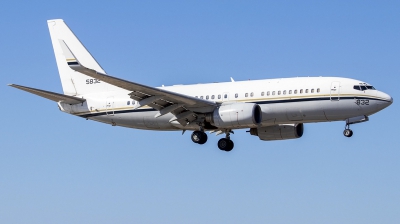
 Random great photos of the Boeing C-40A Clipper (737-7AFC):
Random great photos of the Boeing C-40A Clipper (737-7AFC):
